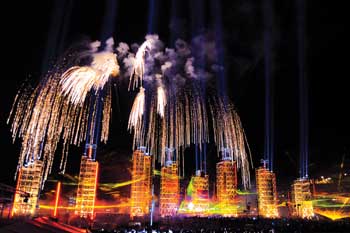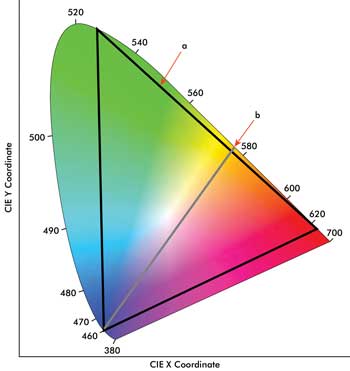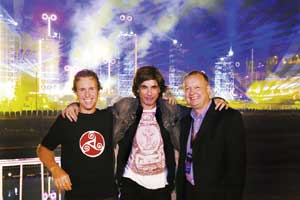Hugo Bunk, Laserimage BV, and Arnaud Lepert and Peter Vogt, !%Coherent Inc.%!
The latest optically pumped semiconductor lasers (OPSLs) enable full-color laser light shows with high electrical efficiency in large outdoor locations, even with challenging weather conditions – as proved at the wedding of Prince Albert of Monaco this summer.
No royal wedding celebration is complete without a giant laser show, but that doesn’t mean pulling off such a large-scale event is as easy as choosing flowers or planning seating arrangements.
When Prince Albert of Monaco married Charlene Wittstock this summer, one of the biggest public celebrations was a live outdoor concert by international performance and recording artist Jean-Michel Jarre, a close friend of the prince. Free in person for all residents of Monaco, it also was viewed on television by between 2 billion and 3 billion people.

The Monaco wedding celebration concert by Jean-Michel Jarre included fireworks, a live laser light show, video, a light cannon and a laser harp performance. Images courtesy of LaserImage BV and Coherent Inc.
Lasers have long been a part of Jarre’s live multimedia performances, which incorporate synthesized music with synchronized visual effects. The wedding concert combined more than 300 W of total laser power together with video on a massive LED-based screen, fireworks, a light cannon and a version of the laser harp first made famous by Jarre himself.
The set list was a combination of Jarre favorites as well as several new pieces written especially for the occasion, such as Wedding March and Vintage. Given its high profile and challenging practical and weather considerations, the event also turned out to be a great test for the latest solid-state lasers, demonstrating their performance and rugged reliability.
Laser shows through the years
Laser light shows date back to the 1960s and have evolved tremendously in terms of complexity, brightness and color, taking advantage of several key advances in laser technology. Original laser light displays simply involved projecting a laser beam onto a flat screen or domed ceiling. Patterns and effects were created either by rapidly modulating and scanning the beam, or passing it through lumia – textured glass or plastic filters that cause visually interesting distortions. Light shows then branched out with 3-D atmospheric effects, which make the entire length of the laser beam visible by projecting it through theatrical fog or pyrotechnic smoke. Today, some of the most dramatic and impressive visuals are images created by quickly scanning one or more laser spots on a “water screen,” a cascade of falling water.

Traditional light shows were based on a limited color palette due to the physics of the available argon and krypton ion lasers. Many of today’s shows use multicolored lasers, which in combination produce spectacular images in true-white and a full range of other colors – just like the red, green and blue pixels of a television display. In addition, the lower cost of ownership of today’s lasers, together with their compact packaging and rugged reliability, means that laser light shows can now be incorporated into a broad spectrum of occasions, from modest local indoor events, openings and concerts to highly produced music concert tours and stadium events.
OPSLs for light shows
The latest generation of light show lasers is all-solid-state. Many of these are based on optically pumped semiconductor laser technology, which has several advantages over earlier gas lasers and even other solid-state lasers. For example, the technology is power-scalable, with many lasers rated at several watts. Just as important, OPSL-based products can be designed and built to output virtually any color in the visible spectrum.
The importance of these characteristics can be seen in the latest red (639 nm) lasers used in large outdoor shows, each of which now output up to 5 W. This deep red is critical in delivering a full-color effect with a wide color gamut. And the high power is necessary for color balance – the human eye is much less sensitive to red light than it is to green, blue and yellow. The only other all-solid-state alternative for this much red power would be laser diodes. Although several of these laser diodes could be ganged up to reach the requisite power level, the beam quality would be poor and not suited to a high-performance show at any significant projection distance. In comparison, OPSLs can produce a circular output beam with low divergence of less than 1.1 mrad, enabling a round spot to be cleanly projected over large distances.

OPSL products deliver 577-nm yellow that, when mixed with 460-nm blue light, creates white light. With the availability of high power at 639 nm, the total color gamut covers much of the human vision response. (a) All colors within the black triangle can be obtained by mixing the output of three lasers at 460, 532 and 639 nm. (b) All colors along the gray line can be obtained by mixing the output of two lasers at 460 and 577 nm.
In addition, because of the nanosecond upper-state lifetime of the gain medium, OPSLs also can be directly modulated at rates of up to 100 kHz simply by switching their drive current. And whether we are talking about dynamic beam shows such as the recent Monaco concert or complex images on a water screen, fast on/off modulation of the laser beam is just as important as fast deflection of that beam. So the ability to directly modulate an OPSL eliminates the cost and complexity of some of the usual external modulation equipment.
Live from Monaco
Jarre performed the Monaco wedding concert on a large stage – nearly 100 m wide – in the harbor of the tiny principality; it lasted just over two hours. The laser engines were placed on a floating concrete platform normally used as a support area for the annual Formula One car race. The entire show, including the laser effects, was choreographed by Jarre with the assistance of lighting designer Ignace D’haeze. The laser effects were supplied by LaserImage, a more-than-20-year veteran of laser light show technology, which has worked with Jarre for more than three years. Virtually all of the total laser power – more than 90 percent – was generated by Coherent’s Taipan line of OPSLs (including 460-, 532-, 577- and 639-nm lasers) to support Jarre’s preference for full-color laser effects. These were incorporated in eight RGB LaserImage laser engines as well as in several extra green and yellow lasers.
High beam quality and superior pointing stability were critical in this show because of the 300-m throw distance separating the laser engines and the stage. But arguably the most important requirement for the lasers used in this event was reliability in the face of unpredictable outdoor conditions; in supporting more than 70 shows for Jarre, often using tens of lasers, LaserImage has never experienced a single OPSL failure.
In Monaco, in particular, the lasers’ exceptional reliability was tested and validated by the harsh operating conditions leading up to the concert. First, the lasers were floating in the harbor, so they were continuously exposed to salt air. Second, they were subjected to huge diurnal changes in ambient temperature and humidity, with the sun beating down on the laser housings for several hours each day. As if this weren’t enough of an environmental challenge, a thunderstorm occurred two days before the performance, preventing scheduled testing of all of the lighting effects – except for the lasers, which were all in perfect working order despite the potential weather catastrophe.
Most of the laser show took the form of beam effects, in which the use of dispersed smoke enables the entire light beam to glow brightly along its path over the stage. The movement and number of the beams were synchronized to the music and other visual effects. As is typical with a Jarre concert, the performance included tracks with heavy usage of time coding as well as several entirely live numbers. (From a technical viewpoint, live tracks are more challenging in terms of synchronizing the lasers and other visuals in real time.)
The famous laser harp used two 10-W green lasers to form a pattern of nine vertical beams on the stage. These were played by Jarre by inserting his hands in the beams, much like playing a real harp. Two photodetectors enable the system to determine which beam is being played; each beam creates a different tone from a midi synthesizer. The midi parameters and the shape of the harp were controlled and changed in real time by Jarre using a foot-operated control unit, resulting in a dynamic performance.
And while all of the laser show (except the harp) was full color, it was also entirely “green” – having a modest carbon footprint, thanks to the high electrical-to-optical conversion efficiency of the OPSL technology. Specifically, the laser effects, including the harp, totaled just more than 300 W of laser power. But the entire electrical power consumption of these lasers was less than 12 kW – a far cry from the blue and green argon-ion lasers used in Jarre’s early shows, which had an electrical efficiency of <0.5 percent and required large amounts of cooling water for stable operation.
Meet the authors
Hugo Bunk is president and founder of LaserImage BV in Amersfoort, Netherlands; e-mail: [email protected]. Arnaud Lepert is director of business management at Coherent Inc. in Santa Clara, Calif.; e-mail: [email protected]. Peter Vogt is sales manager for Germany, Austria and Benelux at Coherent in Dieburg, Germany; e-mail: [email protected].
Q A with composer/performance artist Jean-Michel Jarre
Q: How long have you used lasers in your concerts?
A: Since 1971.

The authors, Hugo Bunk of Laser-Image BV (left) and Peter Vogt of Coherent Inc. (right), pose with performance and recording artist Jean-Michel Jarre during rehearsals a day before the Monaco concert.
Q: Why did you decide to use a laser harp?
A: After [my experimental electronic album] Oxygene, I was thinking that electronic music needed a new range of instruments to be performed onstage ... using light as an interface for music ... and also an instrument [that would be] visible for a wider audience.
Q: What do you consider to be the most important features in a laser?
A: 1 – reliability; 2 – power; 3 – color.
Q: Are there any improvements you would like to see in the lasers you use?
A: On an artistic point of view, we are currently working on new instruments and new graphic developments. On a technical point of view, our priority is to improve how to control the smoke in outdoor situations.